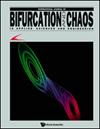一般延迟塞尔科夫-施纳肯伯格反应-扩散系统中的分岔
IF 2.3
4区 数学
Q2 MATHEMATICS, INTERDISCIPLINARY APPLICATIONS
引用次数: 0
摘要
探讨了延迟 Sel'kov-Schnakenberg 反应扩散系统的动力学。以扩散系数和时间延迟为分岔参数,发现了系统图灵分岔和霍普夫分岔的存在和发生条件。在此基础上,给出了包括图灵-图灵、霍普夫-霍普夫和图灵-霍普夫分岔在内的二维分岔的存在性。利用中心流形理论和正常形式方法,证明了图灵-霍普夫分岔在正常数稳态时的普遍展开。根据普适展开,给出了一组特定参数下的图灵-霍普夫分岔图。此外,在不同参数区域,我们发现存在空间非均质稳态、空间均质和非均质周期解。时间和空间的离散化将这些时空解形象化。特别是在霍普夫-霍普夫分岔临界点附近,我们通过数值方法发现了空间均质周期解和非均质准周期解。本文章由计算机程序翻译,如有差异,请以英文原文为准。
Bifurcations in a General Delay Sel’kov–Schnakenberg Reaction–Diffusion System
The dynamics of a delay Sel’kov–Schnakenberg reaction–diffusion system are explored. The existence and the occurrence conditions of the Turing and the Hopf bifurcations of the system are found by taking the diffusion coefficient and the time delay as the bifurcation parameters. Based on that, the existence of codimension-2 bifurcations including Turing–Turing, Hopf–Hopf and Turing–Hopf bifurcations are given. Using the center manifold theory and the normal form method, the universal unfolding of the Turing–Hopf bifurcation at the positive constant steady-state is demonstrated. According to the universal unfolding, a Turing–Hopf bifurcation diagram is shown under a set of specific parameters. Furthermore, in different parameter regions, we find the existence of the spatially inhomogeneous steady-state, the spatially homogeneous and inhomogeneous periodic solutions. Discretization of time and space visualizes these spatio-temporal solutions. In particular, near the critical point of Hopf–Hopf bifurcation, the spatially homogeneous periodic and inhomogeneous quasi-periodic solutions are found numerically.
求助全文
通过发布文献求助,成功后即可免费获取论文全文。
去求助
来源期刊
CiteScore
4.10
自引率
13.60%
发文量
237
审稿时长
2-4 weeks
期刊介绍:
The International Journal of Bifurcation and Chaos is widely regarded as a leading journal in the exciting fields of chaos theory and nonlinear science. Represented by an international editorial board comprising top researchers from a wide variety of disciplines, it is setting high standards in scientific and production quality. The journal has been reputedly acclaimed by the scientific community around the world, and has featured many important papers by leading researchers from various areas of applied sciences and engineering.
The discipline of chaos theory has created a universal paradigm, a scientific parlance, and a mathematical tool for grappling with complex dynamical phenomena. In every field of applied sciences (astronomy, atmospheric sciences, biology, chemistry, economics, geophysics, life and medical sciences, physics, social sciences, ecology, etc.) and engineering (aerospace, chemical, electronic, civil, computer, information, mechanical, software, telecommunication, etc.), the local and global manifestations of chaos and bifurcation have burst forth in an unprecedented universality, linking scientists heretofore unfamiliar with one another''s fields, and offering an opportunity to reshape our grasp of reality.

 求助内容:
求助内容: 应助结果提醒方式:
应助结果提醒方式:


